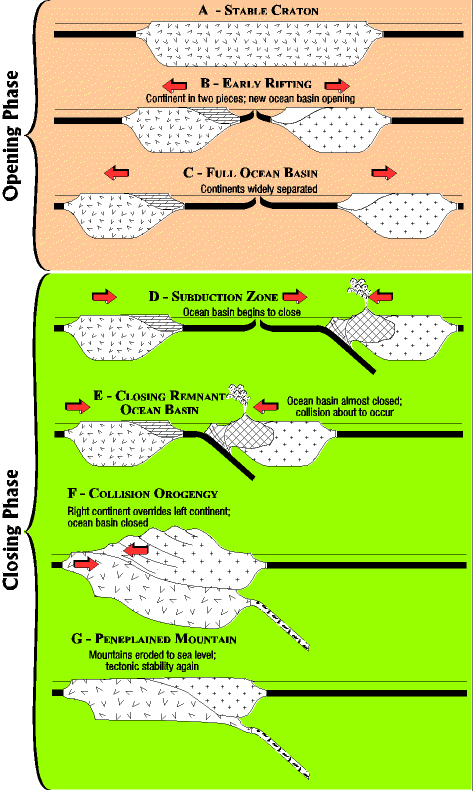|
The Wilson cycle begins in Stage A with a stable continental craton. A hot spot (not present in the drawings) rises up under the craton, heating it, causing it to swell upward, stretch and thin like taffy, crack, and finally split into two pieces. This process not only splits a continent in two it also creates a new divergent plate boundary. Stage B - the one continent has been separated into two continents, east and west, and a new ocean basin (the ophiolite suite) is generated between them. The ocean basin in this stage is comparable to the Red Sea today. As the ocean basin widens the stretched and thinned edges where the two continents used to be joined cool, become denser, and sink below sea level. Wedges of divergent continental margins sediments accumulate on both new continental edges. Stage C - the ocean basin widens, sometimes to thousands of miles; this is comparable to the Atlantic ocean today. As long as the ocean basin is opening we are still in the opening phase of the Wilson cycle. Stage D - the closing phase of the Wilson Cycle begins when a subduction zone (new convergent plate boundary) forms. The subduction zone may form anywhere in the ocean basin, and may face in any direction. In this model we take the simplest situation; a subduction zone developing under the edge of one continent. Once the subduction zone is active the ocean basin is doomed; it will all eventually subduct and disappear. These are remnant ocean basins. Stage E - most of the remnant ocean basin has subducted and the two continents are about to collide. Subduction under the edge of a continent has a lot of results. Deep in the subduction zone igneous magma is generated and rises to the surface to form volcanoes, that build into a cordilleran mountain range (e.g. the Cascade mountains of Washington, Oregon, and northern California.) Also, a lot of metamorphism occurs and folding and faulting. Stage F - the two continents, separated in Stages A and B now collide. The remnant ocean basin is completely subducted. Technically the closing phase of the Wilson cycle is over. Because the subduction zone acts as a ramp the continent with the subduction zone (a hinterland) slides up over the edge of the continent without it (a foreland). Stage G - once the collision has occurred the only thing left for the mountain to do is erode down to sea level - a peneplain. The stage G drawing is a distortion, however. With the collision the continental thickness doubles, and since continental rock is light weight, both will rise as the mountain erodes, much like a boat rises when cargo is taken off of it. Thus, in reality, most of the hinterland continent will be eroded away, and the foreland continent will eventually get back to the earth's surface again. |
 |